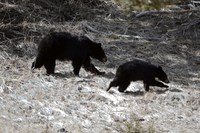Delayed Implantation
When Timing is Everything
Post Register May 23, 2013
Seven weeks before his due date, Adam demanded an audience with the world. My new grandson would have benefited from the extra time in the womb, but he wouldn't have it.
Each mammal species has a gestation period, the time it takes for a fertilized egg to develop into a newborn. For humans, it is 40 weeks. Some rodents take as few as three weeks and an elephant takes 22 months.
But in the wild, reproduction isn’t as easy as, find a mate, get pregnant, and give birth at the end of the gestation. Timing is everything.
For instance, what if a mother is still nursing young from a previous litter? What if food is so scarce giving birth would be foolhardy? What if mates are available in the fall, but food is most abundant in the spring?
For more than 100 species of mammals -- from diverse groups such as seals, weasels, shrews, mice, kangaroos, bats, armadillos, red pandas and bears -- nature has developed a reproductive system for coping with an unpredictable environment. This prudent strategy tailors the reproductive cycle to match annual food availability and weather.
It is called delayed implantation, where the fertilized egg develops into a microscopic 50-cell ball, a blastocyst, which floats freely in suspended animation until the mother is physiologically “persuaded” that pregnancy can be successful. Then it attaches, or implants, into the uterine wall and begins development.
Take, for example, a mouse with a new litter. She immediately mates again, but is nursing the new kids. If the first litter isn’t weaned before the second one arrives, the newborns wouldn’t survive in a competition for milk. Called facultative delay, the suckling young trigger a postponement in the implantation of new embryos until the first litter is weaned.
In other species, delayed implantation is obligatory. A bear mates in the summer, but the implantation of the blastocysts occur months later. The gestation may be six months or more, but the actual development from the blastocyst to newborn is much shorter.
There are adaptive advantages for the delay. The mother’s body can determine if it is physiologically capable of sustaining a pregnancy and how many embryos to implant.
For many predators -- such as weasels, martens and skunks -- food is most available in the springtime, but mating occurs in the summer and fall. Once implantation occurs, delivery may be only 34 days away. Delayed implantation solves the timing issue, waiting until the mother has ample resources for raising her young and teaching them how to survive.
Because it crosses so many phylogenic lines, delayed implantation may have developed independently along a number of evolutionary pathways and geologic times which complicates research. Like so many things in nature, with delayed implantation, there are as many questions as there are answers. For instance, why does the long-tailed weasel delay for months while its close relative, the least weasel experience no delay?
Although unraveling the science of delayed implantation is years away, one day it may yield clues to mysteries such as how to stop rapidly dividing cancer cells. Once again, nature may save us if we will let it.
By Terry Thomas

Delayed implantation allows the bear to physiologically make a “decision” whether or not to have cubs based on environmental conditions.